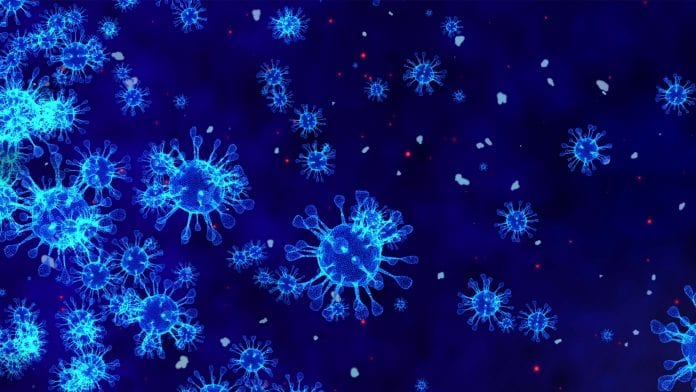
Drs Andrew Buchan and Liang Yang speak to HEQ about the potential of far-UVC for disinfecting indoor airflow.
The risk of contracting COVID-19 has been shown to be significantly higher in spaces such as hospitals and long-term care facilities, exacerbated by the presence of high indoor populations and patients and residents who may be vulnerable to infection. One proposed solution to the spread of aerosolised infection in indoor spaces is far-UVC radiation, which inactivates harmful bacteria and viruses – including COVID-19 – with minimal to no risk to any humans in the path of the radiation.
In a 2020 study titled ‘Predicting airborne coronavirus inactivation by far-UVC in populated rooms using a high-fidelity coupled radiation-CFD model’, Drs Andrew Buchan and Liang Yang modelled the potential of wider deployment of far-UVC for disinfecting indoor airflow. They discuss their findings with HEQ.
How does UVC disinfection work? What key advantages does it offer in comparison to other common disinfection methods?
UVC light is the part of electromagnetic spectrum with wavelengths between 200nm and 280nm; and is invisible to the human eye. It has been known for a very long time that it is effective at inactivating pathogens (they absorb the UVC light, which damages their DNA and RNA) and has, for decades, been used to disinfect surfaces, air and drinking water. The most commonly used UVC devices are the mercury-vapour arc lamps that emit 254nm UVC. However, this type of UVC radiation is also damaging to people; and therefore can only be employed in unoccupied regions of a room, or in shielded devices and ventilation systems.
How can far-UVC disinfection aid in the fight against the airborne spread of COVID-19?
Recent studies have shown that a specific UVC wavelength between 207nm and 222nm (the far-UVC range) cannot penetrate either the human corneum or ocular tear layer. Therefore, unlike standard UVC, it is neither a carcinogenic nor a cataractogenic, and so can be safely used around humans. It can therefore be used within occupied rooms, which is a paradigm shift in the use of UVC light at killing microorganisms. In particular, it can be used to suppress COVID-19 transmission through aerosols and so can reduce the risk of spread in all enclosed environments, particularly those with poor ventilation.
Our recent study, published in the Scientific Reports journal, showed that using far-UVC within the current recommended intensities can provide similar levels of virus reductions as wearing N95 mask, and provides up to 80% further reductions in airborne virus levels when using ventilation for their extraction. Far-UVC lighting could therefore provide an alternative and safe way to mitigate SARS-CoV-2 transmission.
Did you observe any significant limitations or challenges associated with far-UVC disinfection?
Our modelling work was concerned only with the inactivation of virus within occupied rooms, working with the current estimates of virus susceptibility to far-UVC, and the currently accepted safe levels of far-UVC exposure. One challenge we envisage is in trying to maximise the efficacy of virus inactivation by the placement of a lamp. A room’s air flow is very dynamic and complex, aerosols are transported in many ways and a lamp will provide varying levels of intensity depending on its distance and by shadows from obstructing furniture. A lamp’s position can have a large impact on amount of virus inactivation, which of course you would like to maximise, but this is difficult to determine as it requires the optimisation of a multi-physics (radiation and fluids flow) problem.
What are some potential future applications for far-UVC disinfection?
One crucial advantage of using far-UVC technologies is that they can be used and installed as you would a light fitting within a room. They are small devices the size of lightbulbs that require no additional shielding, and this makes them easy to install. Furthermore, UVC (and far-UVC) is effective in killing most pathogens and so is not limited to just COVID-19, but also other diseases both current and future. This could be crucial in the early fight against any future pandemic whilst vaccines are being developed.
Do you intend to conduct additional or more targeted research in this field?
We will focus on the prediction and optimisation of efficiency of far-UVC disinfection through computer simulation. The efficacy is dependent on many factors – for example, atmospheric condition, placement of lamps and furniture, or the movement of people – which will influence the flow in the room and far-UVC illumination. Experimental testing is not adequate to predict efficacy in a reliable manner and it is not always feasible to build laboratory representations of every possible circumstances, or to test efficacy in situ. These tests can only be performed by the validated simulation computer codes. We have built a unique validated high-fidelity model, which takes into account the fluid flow, aerosol dynamics and radiation transport to quantify efficacy. This will provide reliable guidance and implications for risk assessment in the workplace or spaces.
Dr Liang Yang
Cranfield University
Dr Andrew Buchan
Queen Mary University
www.cranfield.ac.uk/people/dr-liang-yang-23276693
www.sems.qmul.ac.uk/staff/a.buchan
This article is from issue 17 of Health Europa. Click here to get your free subscription today.










